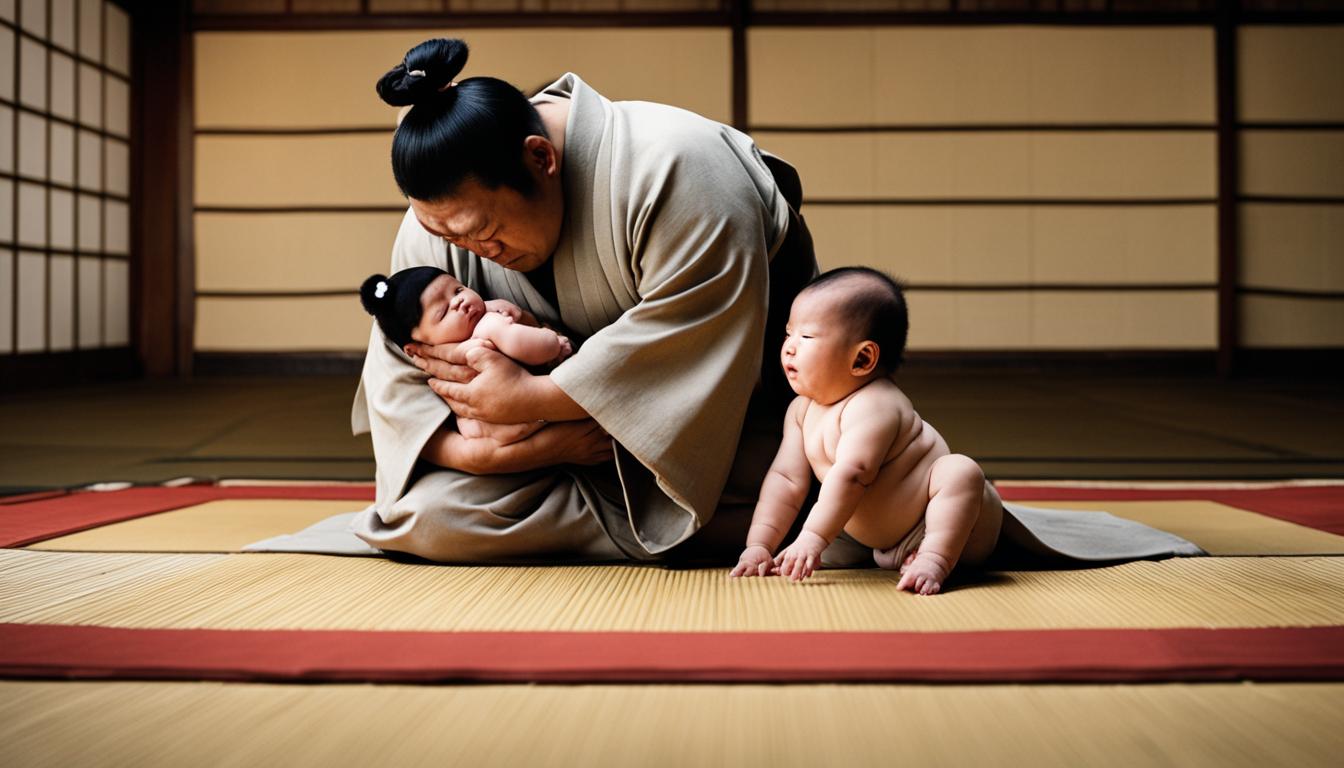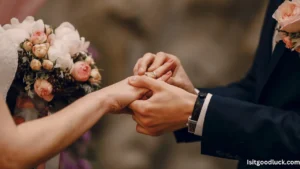Have you ever wondered if a sumo wrestler making your baby cry could bring you good luck? In Japan, this centuries-old ritual is believed to do just that. Sumo wrestlers participate in a unique ceremony where they try to make babies cry in order to ward off evil spirits and ensure the child’s future good fortune. This cultural belief, celebrated annually at various locations in Japan, dates back 400 years and continues to be cherished by parents and communities.
Contents
- 1 The Baby-Cry Sumo Competition in Tokyo
- 2 The Naki Sumo Crying Baby Festival
- 3 Customs and Traditions of Naki Sumo
- 4 Popular Naki Sumo Festivals in Japan
- 5 Conclusion
- 6 FAQ
- 6.1 Is it considered good luck if a sumo wrestler makes your baby cry?
- 6.2 Where does the baby-cry sumo competition take place in Tokyo?
- 6.3 What is the Naki Sumo Crying Baby Festival?
- 6.4 What are some customs and traditions of Naki Sumo?
- 6.5 Where are some popular Naki Sumo festivals held in Japan?
- 6.6 What is the significance and symbolism of baby crying in sumo?
- 6.7 Why is the tradition of a sumo wrestler making a baby cry important in Japanese culture?
- 7 Source Links
Key Takeaways:
- The act of a sumo wrestler making a baby cry in Japan is believed to bring good luck and ensure the child’s healthy growth.
- The ritual is a centuries-old tradition that involves warding off evil spirits and ensuring the child’s future good fortune.
- Sumo wrestlers participate in ceremonies held at shrines nationwide, with variations of the ritual depending on the location.
- One popular competition, known as the Naki Sumo Crying Baby Festival, is held at Shinto shrines throughout Japan.
- The crying of the baby is seen as a symbol of protection and is believed to have the power to ward off demons or evil spirits.
- The tradition reflects the cultural belief in the connection between emotions, spirituality, and the child’s well-being.
- While the tradition may seem unusual to outsiders, it highlights the rich tapestry of customs and traditions in different cultures.
The Baby-Cry Sumo Competition in Tokyo
At the Irugi Shrine in Tokyo, more than a hundred babies, aged between six and 18 months, participate in the baby-cry sumo competition. Sumo wrestlers bounce the babies up and down in a makeshift sumo ring, while their parents watch with excitement. The goal is to make the babies cry, as their tears are believed to reach God and ensure their healthy growth. This event is a cherished tradition for Japanese parents, who see it as a unique way to connect with their cultural heritage.
During the baby-cry sumo competition, the babies are dressed in traditional attire and held gently by the sumo wrestlers. These wrestlers, known for their immense strength, use their expertise to create a rhythmic bouncing motion that often causes the babies to shed a tear. The competition is conducted in a lighthearted and playful manner, with the wrestlers using various techniques to encourage crying, such as making funny faces, tickling, or gently rocking the babies.
Parents and spectators enthusiastically cheer on the participants, believing that the crying of the babies brings good luck and ensures their future well-being. The event not only showcases the strength and skill of the sumo wrestlers but also fosters a sense of community and cultural pride. It serves as a reminder of the rich traditions and beliefs that have been passed down through generations in Japan.
The Naki Sumo Crying Baby Festival
The Naki Sumo Crying Baby Festival, also known as Nakizumō, is an annual Japanese festival held at Shinto shrines throughout the country. This centuries-old tradition brings together two babies in a short match within an open-air sumo ring, where the first child to cry is declared the winner. The festival is celebrated on or around May 5, coinciding with Children’s Day, and is a part of the Golden Week holiday.
The Naki Sumo festival holds deep cultural significance in Japan, as it is believed to have originated from the folk belief that the loud cry of an innocent baby can ward off demons or evil spirits. The ritual is performed as a means to protect the child and ensure their healthy growth. The competition aspect adds an element of excitement to the festival, with spectators cheering on the babies as they compete to be the first to shed tears.
During the festival, each baby wears a handmade kabuto helmet and is held by a professional or student sumo wrestler in a sumo wrestling ring. The wrestlers employ various techniques to encourage crying, such as bouncing the baby, making loud noises, and using funny or scary facial expressions. The festival begins with a Shinto priest performing rituals to pray for the healthy growth of each baby, adding a spiritual aspect to the event.
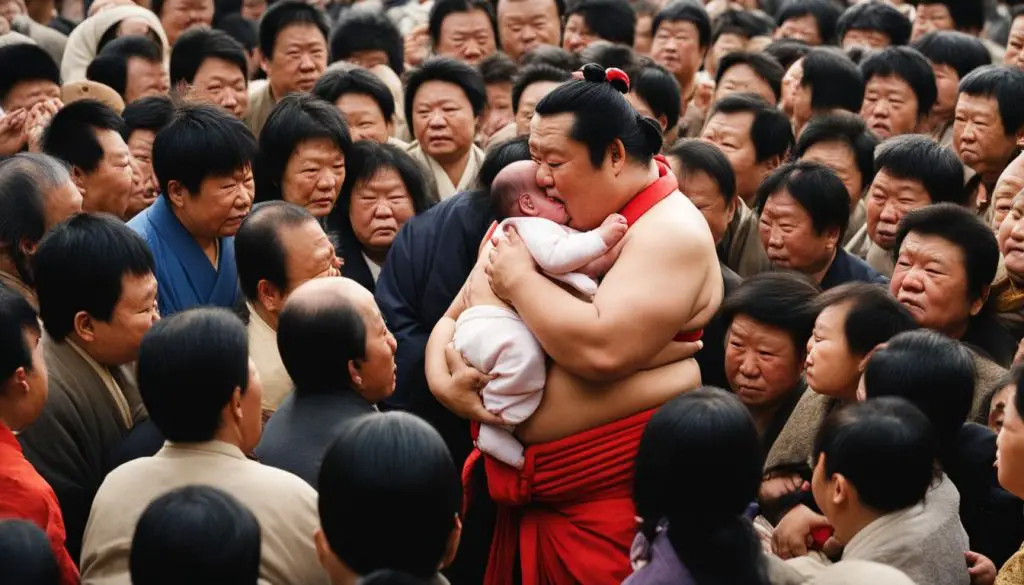
Table: Naki Sumo Festival Schedule
| Time | Activity |
|---|---|
| 9:00 AM | Opening rituals and blessings by Shinto priest |
| 10:00 AM | Naki Sumo competition begins |
| 12:00 PM | Award ceremony for winners |
| 1:00 PM | Cultural performances and entertainment |
| 3:00 PM | Closing rituals and prayers |
The Naki Sumo Crying Baby Festival is a unique celebration that showcases the rich cultural traditions of Japan. It allows parents and communities to connect with their heritage and pass down these customs to the next generation. The festival’s enduring popularity speaks to its importance in Japanese society, and its message of protection and well-being resonates with people from all walks of life.
Customs and Traditions of Naki Sumo
Each Naki Sumo festival has its own customs and traditions that add depth and meaning to the crying competition. The festivities begin with a Shinto priest performing sacred rituals to pray for the healthy growth and well-being of each participating baby. These rituals, passed down through generations, seek blessings for the infants and invoke divine protection. The babies, dressed in adorable handmade kabuto helmets, are entrusted to professional or student sumo wrestlers who hold them in a traditional sumo wrestling ring.
The sumo wrestlers employ various techniques to encourage crying, such as gently bouncing the babies, making loud noises, and pulling funny or scary faces. The goal is to elicit a strong emotional response from the babies, as their tears are believed to carry prayers to the heavens. The first baby to cry is declared the winner, symbolizing the successful expulsion of evil spirits and the bestowing of good health upon the child.
“We believe that the act of crying cleanses the baby’s spirit and ensures their future well-being. It’s a powerful moment where tradition, culture, and spirituality intersect,” says Hiroshi Nakamura, a sumo wrestler and participant in the Naki Sumo festival.
The Significance of the Sumo Wrestling Ring
The sumo wrestling ring, or dohyo, holds great significance in the Naki Sumo festival. The ring serves as a sacred space where sumo wrestlers and babies come together to perform the ritual. It represents the traditional Japanese values of strength, unity, and balance. The sumo wrestlers holding the babies carefully navigate the ring, creating a harmonious connection between the past and the present.
The presence of the sumo wrestling ring also reinforces the cultural importance of sumo wrestling in Japan. Sumo is more than just a sport; it is deeply ingrained in the country’s history, traditions, and identity. By incorporating the sumo ring into the Naki Sumo festival, the event pays homage to this beloved national sport and further emphasizes the spiritual aspects of the ritual.
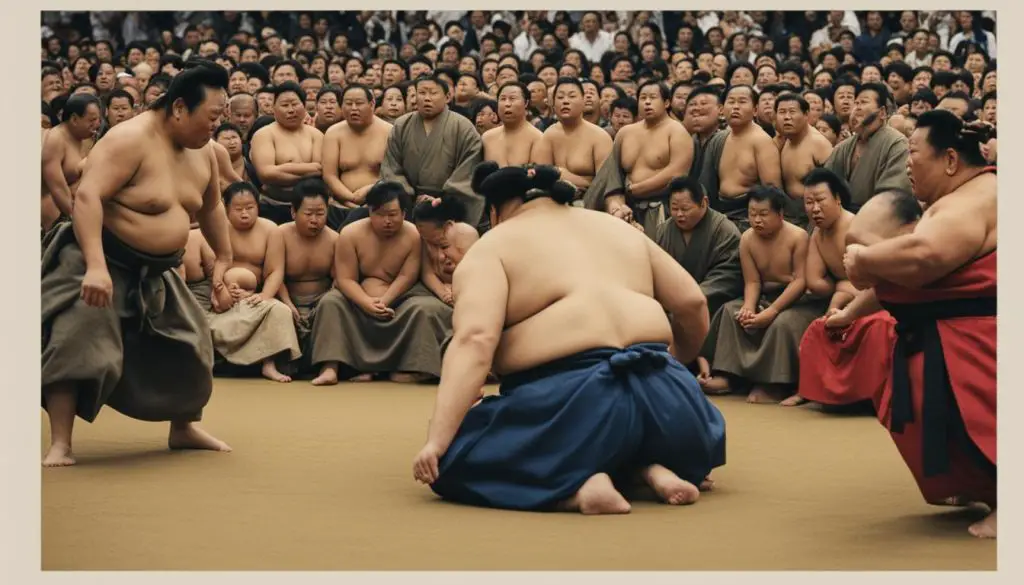
A Celebration of Customs and Heritage
The Naki Sumo festival is not only a crying competition but also a celebration of customs and heritage. It brings families and communities together to honor and cherish this unique tradition that has been passed down for centuries. Parents, grandparents, and relatives gather to support the babies and rejoice in their cries, knowing that it symbolizes their protection and good fortune.
The festival atmosphere is filled with excitement, as participants and spectators cheer on the babies with a phrase meaning “live long.” This communal spirit showcases the strong sense of community and shared cultural values that are an integral part of Japanese society. The Naki Sumo festival serves as a reminder of the power of tradition in connecting people and preserving cultural identity.
Popular Naki Sumo Festivals in Japan
Japan is home to several popular Naki Sumo festivals that attract participants and spectators from all over the country. These festivals showcase the unique cultural tradition of sumo wrestlers trying to make babies cry for good luck and health. Two of the most renowned Naki Sumo festivals are held at the Sensō-ji temple in Asakusa, Tokyo, and the Gokoku Shrine in Hiroshima.
Sensō-ji Temple, Asakusa, Tokyo
At the Sensō-ji temple in Asakusa, the Naki Sumo festival offers a fascinating experience for both locals and tourists. Student sumo wrestlers hold the babies and raise them higher in the air when they start crying, believed to amplify the blessings bestowed on each child. The lively atmosphere, vibrant costumes, and the sight of babies being bounced gently by the sumo wrestlers create a captivating spectacle that showcases the cultural richness of Japan.
Gokoku Shrine, Hiroshima
Another notable Naki Sumo festival takes place at the Gokoku Shrine in Hiroshima. This festival follows a unique format where babies are dressed in adorable kimonos and seated facing each other on pillows. A sumo referee encourages the babies to cry, while spectators cheer them on. This festival not only celebrates the tradition of Naki Sumo but also highlights the cultural significance of sumo wrestling in Japan.
| Nakizumo Festival | Location |
|---|---|
| Sensō-ji Temple | Asakusa, Tokyo |
| Gokoku Shrine | Hiroshima |
These Naki Sumo festivals offer a window into the rich cultural heritage of Japan. They provide an opportunity for families to come together, celebrate their traditions, and enjoy the festivities. The festivals not only entertain the crowd but also serve as a reminder of the deep-rooted beliefs and superstitions that have shaped Japanese culture for centuries.
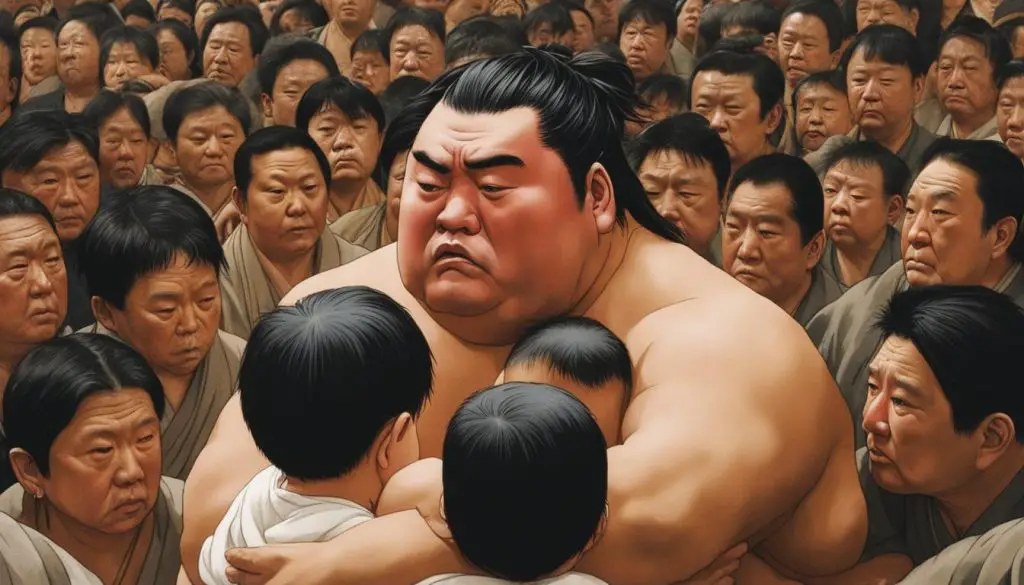
| Symbolism of Crying Baby in Sumo | Meaning |
|---|---|
| Warding off Evil Spirits | Crying baby is believed to repel evil spirits and protect the child from harm. |
| Good Health | A strong, loud cry symbolizes good health and ensures the child’s healthy growth. |
| Community Prosperity | The act of making the baby cry is believed to bring good fortune to the community as a whole. |
This tradition serves as a reminder of the rich tapestry of customs and traditions found in different cultures around the world. While it may seem unusual to outsiders, the significance of the crying baby in the sumo ritual highlights the depth of cultural beliefs and superstitions that shape our understanding of luck, protection, and the well-being of our loved ones.
Conclusion
The tradition of a sumo wrestler making a baby cry in Japan is deeply rooted in cultural belief and superstition. It is seen as a way to bring good luck and ensure the baby’s healthy growth. This unique ritual has been celebrated for centuries and continues to be cherished by Japanese parents and communities.
The act of a baby crying is viewed as a symbol of protection and a means to ward off evil spirits. It is believed that the louder the baby’s cry, the more effective the ritual is in safeguarding the child’s future. This tradition reflects the Japanese cultural belief in the connection between emotions, spirituality, and well-being.
While the tradition may seem unusual to outsiders, it highlights the rich tapestry of customs and traditions found in different cultures around the world. The sumo wrestler’s role in making a baby cry serves as a reminder of the power of cultural beliefs and the importance of honoring and preserving these traditions.
Whether seen as a cultural curiosity, a superstition, or a profound symbol, the act of a sumo wrestler making a baby cry remains an integral part of Japan’s cultural heritage and an intriguing glimpse into the fascinating rituals and customs that shape our world.
FAQ
Is it considered good luck if a sumo wrestler makes your baby cry?
Yes, in Japanese culture, it is believed that if a sumo wrestler is able to make your baby cry, it brings good health and ensures the child’s future good fortune.
Where does the baby-cry sumo competition take place in Tokyo?
The baby-cry sumo competition takes place at the Irugi Shrine in Tokyo, where more than a hundred babies aged between six and 18 months participate.
What is the Naki Sumo Crying Baby Festival?
The Naki Sumo Crying Baby Festival, also known as Nakizumō, is an annual Japanese festival held at Shinto shrines throughout the country. It is a crying competition where two babies compete in a short match to see who cries first.
What are some customs and traditions of Naki Sumo?
The festival begins with a Shinto priest performing rituals to pray for the healthy growth of each baby. The babies wear handmade kabuto helmets and are held by professional or student sumo wrestlers. Various techniques are used to encourage crying, such as bouncing the baby, making loud noises, and funny or scary facial expressions.
Where are some popular Naki Sumo festivals held in Japan?
Some popular Naki Sumo festivals in Japan take place at the Sensō-ji temple in Asakusa, Tokyo, and the Gokoku Shrine in Hiroshima.
What is the significance and symbolism of baby crying in sumo?
According to Japanese folklore, a crying baby has the power to ward off evil spirits, and a strong, loud cry indicates that the child will grow up strong and healthy. Making the baby cry is believed to be cathartic and ensures the child’s good health and protection.
Why is the tradition of a sumo wrestler making a baby cry important in Japanese culture?
The tradition is deeply rooted in cultural beliefs and superstitions. It is seen as a way to bring good luck and ensure the baby’s healthy growth, reflecting the cultural belief in the connection between emotions, spirituality, and well-being.
Source Links
- https://en.wikipedia.org/wiki/Naki_Sumo_Crying_Baby_Festival
- https://www.businessinsider.com/afp-having-a-bawl-japans-sumo-wrestlers-grapple-with-cry-babies-2014-9
- https://www.dailymail.co.uk/news/article-3566873/Heavyweight-tearjerker-Sumo-wrestlers-attempt-make-babies-CRY-ancient-Japanese-festival-believed-ward-evil-spirits-bring-good-health.html

